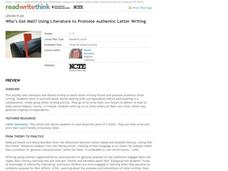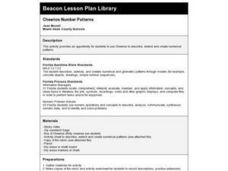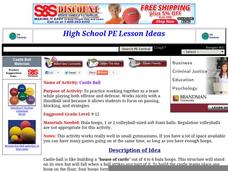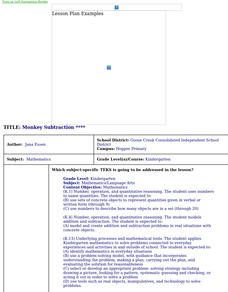Curated OER
Are You Full of Hot Air?
Explore the concept of measuring and recording circumference. In this physical science and measurement lesson, young learners blow up balloons, measure the circumference, and record the data on an interactive graphing website.
Curated OER
Shapes and Tools
Young learners view different shapes drawn by the teacher on the board. The teacher identifies each shape by name and discusses the importance of knowing the difference between shapes when building something. The pupils complete the...
Curated OER
M&M Graphing
Youngsters sort M & M's by color. They graph the M&M's by color on a graph. This classic lesson is a wonderful way to introduce the concept and technique of graphing to young mathematicians. Pairs of kids can make up their own...
Curated OER
The Emergence and Evolution of the Cuneiform Writing System in Ancient Mesopotamia
Students explore the parallel development and increasing complexity of writing and the growth of civilization in the Tigris and Euphrates valleys in ancient Mesopotamia.
Beacon Learning Center
Spotted Stones Linked Just Right
Discover how to play the game of dominoes using mental math skills to solve equations that earn points. Pupils become fast critical thinkers in determining which unknown addend tally up points in their favor.
Curated OER
The Golden Students
Scholars view the video, "Donald Duck in Mathmagic Land," and discuss examples in nature which have proportions of the golden ratio. They measure and record different body lengths from a worksheet and convert the ratios to equivalent...
Curated OER
Understanding the Water Cycle
Investigate the water cycle and how water moves from the land to the air and back to the land. Create a terrarium and observe the water cycle at work. Define weather terms including evaporation, condensation, and precipitation.
ReadWriteThink
Who’s Got Mail?
Today's kids are probably not familiar with the conventions of letter writing, due to the boom of technology. Here is a lesson that will provide opportunities for formal and informal letter writing.
Curated OER
An Introduction to the Relationship Between Composition and Content in the Visual Arts
High schoolers investigate how artists create a story that provides a message or provokes emotions in a single image. The ways in which the composition of a painting contributes to telling the story or conveying the message is examined...
Curated OER
Let's Focus on Idioms
Get online and explore idioms. Your class will use the Internet to locate, choose, and illustrate their favorite idioms. They make a class PowerPoint with illustrations for their idioms and explain the meaning of each. A great way to...
Curated OER
The Counting Caterpillar
A daily counting routine builds a caterpillar with 100 body segments (marked with symbols to indicate 2s, 5s, and 10s) by the 100th day of school. Provides structured repetition as part of the morning routine so that by 100th day,...
Curated OER
Grab a Handful and Count
Let's use Fruit Loops to teach counting skills! Pupils practice counting one-to-one correspondence using Fruit Loops with a partner and then compare them to see who has more or less.
Curated OER
Cheerios Number Patterns
Young scholars, following a provided worksheet, use Cheerios to explore number patterns.
Curated OER
Castle Ball
In teams, students practice working together playing offense and defense in the game of handball. Students use hula hoops to build a castle while the other team tries to knock it down.
Curated OER
Shadows and Skyscrapers
Eighth graders explain the relationship between the position of the sun, a city's latitude and shadow length. Ratio's, geometry, and algebra are used to determine the shadow lengths and building heights. A sun angle (altitude) charts to...
Curated OER
Simply Speaking
Emerging orators distinguish between effective and ineffective public speaking strategies. They read a text that fits in with a Native Americans unit and speak about the text with both ineffective and effective volume, tone, phrasing,...
Curated OER
So Many Cats!
First graders listen to the book, So Many Cats, and discuss the number of cats in the story. They demonstrate simple addition problems using cat counters and a work mat in the shape of a house.
Curated OER
Shaping the View: Composition Basics
Students are introduced to the concept of composition in visual art. They examine various compositional structures and practice identifying the focus of various pieces of art.
Curated OER
Noodle Knockdown
Students perform a proper overhand throw. For this physical education lesson, students practice overhand throwing using specific sequential cues such as "statue" and "muscleman". Each step is explained in detail. Students play a team...
Curated OER
Snatch And Strike
Students reinforce striking with a short-handled implement using an overhand, underhand, or sidearm motion.
Curated OER
What's The Matter: A Sinker or Floater?
Students conduct an experiment. For this water lesson, students watch the lesson "Float and Sink" on an interactive website. Students learn how to test items in water and then work in groups to test their items. Students discuss their...
Curated OER
Healthy Eaters
Students classify foods as "healthy" or "unhealthy" and sort foods into appropriate food groups. In this nutrition/physical education lesson, students play a game in which throwing skills are practiced. Pictures of food are sorted into...
Curated OER
Striking: Accuracy and Power
Young scholars gain an understanding of the concept of accuracy and power as it relates to the length of striking implements used.
Curated OER
Monkey Subtraction
Students listen to the book Five Little Monkeys Sitting In a Tree, identify written numbers 0-9 and the symbol for subtraction; students subtract two single digit numbers using manipulatives, and recite the corresponding number sentence.























